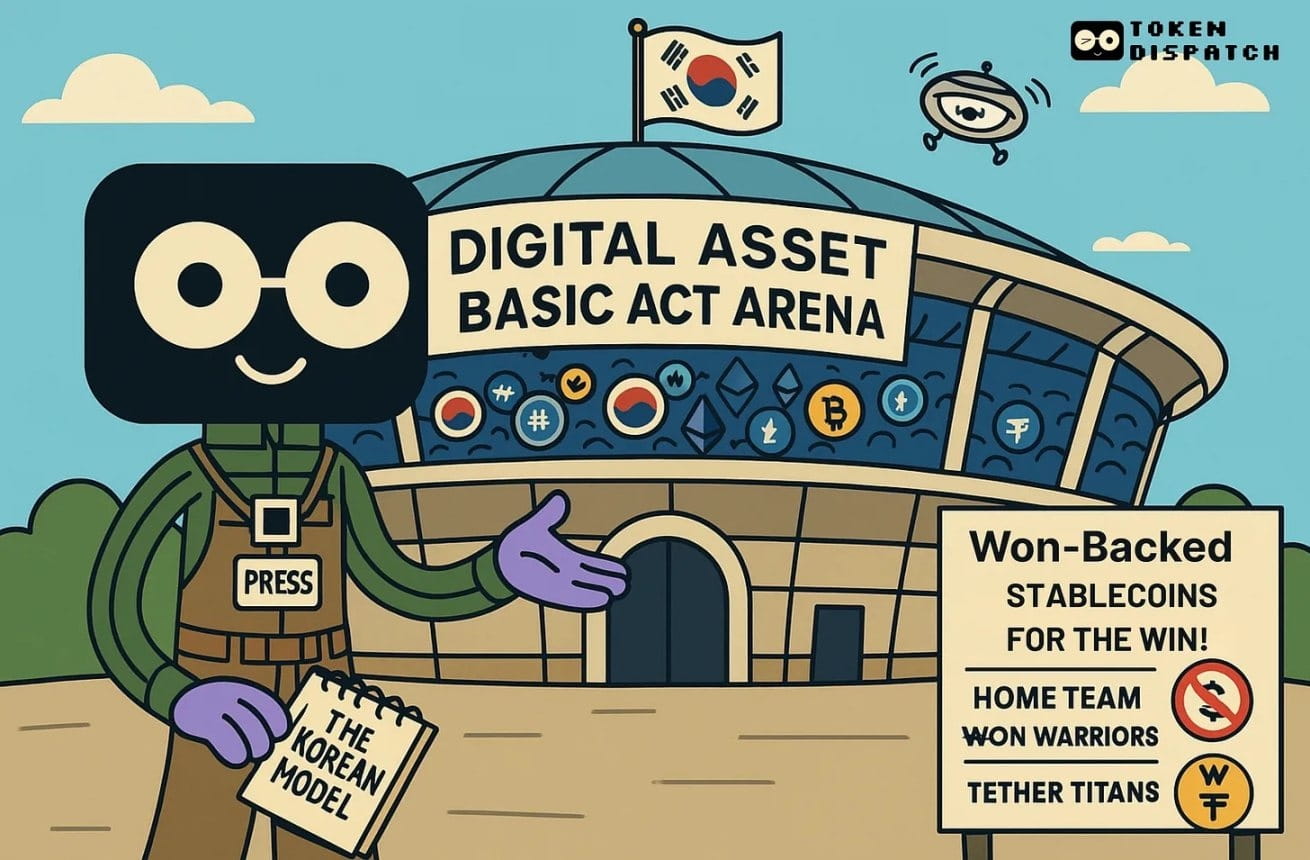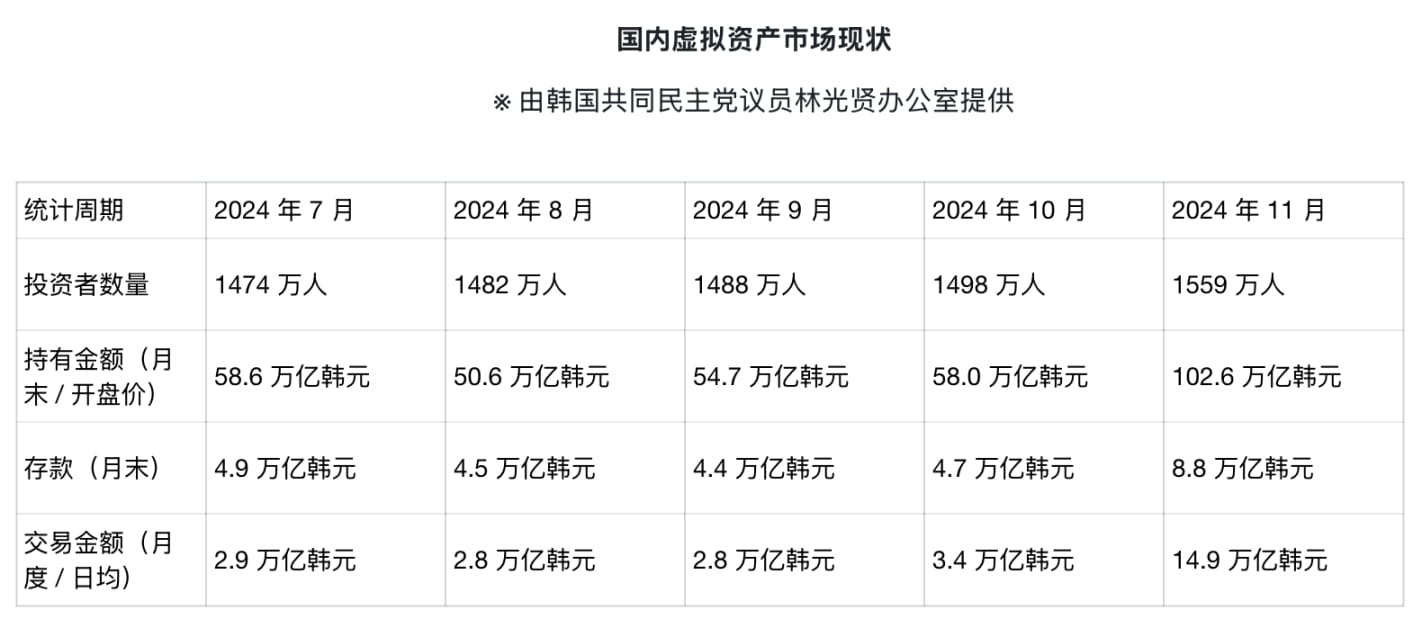Written by: Thejaswini M A
Translated by: Saoirse, Foresight News
On that bizarre night in December 2024, former President Yoon Suk-yeol announced the implementation of martial law, deploying troops to the National Assembly and even attempting military action against North Korea. He probably never imagined that this political suicide farce would give rise to one of the most radical cryptocurrency policy agendas in the world.
And that is indeed the case.
This two-hour failed coup ended in impeachment, creating a power vacuum. Filling this void was Lee Jae-myung, known as the 'disruptor.' With a unified government team and clear governing authority, the Lee Jae-myung government introduced the Digital Asset Basic Act just days after taking office and began to abolish the eight-year-long restrictions on corporate cryptocurrencies.

Before delving deeper, it is important to clarify one point about South Korea: it is a technologically advanced economy with a broad public awareness of cryptocurrencies, while also facing structural economic challenges that traditional monetary policies cannot address. Cryptocurrencies provide strategies to alleviate current economic pressures and lay the foundation for long-term competitive advantages.
Currently, the number of people holding cryptocurrency accounts in South Korea has reached 16 million, surpassing the 14.1 million stock investors in the country. This marks the first time in South Korean history that retail participation in digital assets has exceeded that in traditional stocks.
Nearly one-third of South Korea's population participates in cryptocurrency trading, with this proportion exceeding half among adults under 60. The total cryptocurrency holdings disclosed by 20% of government officials amount to approximately 9.8 million USD. According to a report by the Hanwha Financial Research Institute, 27% of South Koreans aged 20 to 50 hold cryptocurrencies, and digital assets account for 14% of their financial asset portfolios.
This is the result of years of increasing cryptocurrency applications, driven by economic pressures, public familiarity with technology, and the political system ultimately choosing to align with rather than resist this change.

Data source: @yna
Economic Foundation
South Korea's acceptance of cryptocurrencies stems from real economic pressures that traditional policy tools have failed to address. The country's GDP growth forecast for 2025 is only 0.8%, a figure typically seen only during major financial crises. In March 2025, the youth unemployment rate rose to 7.5%, the highest level for the same period since 2021.
Korea's national debt to GDP ratio is approaching 47% - 48%, having risen after the pandemic and now stabilizing. By the end of 2024, the household debt to GDP ratio in South Korea is projected to reach 90%-94%, ranking among the highest globally, particularly leading among major developed economies and Asian countries. This stands in stark contrast to other major economies, where government debt often exceeds household debt. In the U.S., household debt accounts for 69.2% while government debt is 128%; Japan's government debt ratio is as high as 248%, while household debt is only 65.1%. South Korea's inverted debt structure brings unique economic pressures: policy decisions are more driven by individual financial pressures rather than sovereign fiscal concerns.
When interest rates rise and economic growth stagnates, this debt burden can drag down consumer spending, which cannot be resolved by monetary policy alone.
For millions of young South Koreans, cryptocurrencies represent what researcher Eli Ilha Yune describes as 'financial desperation.' This is not due to ideological support for blockchain technology, but rather a realistic response to an economy with few other avenues for wealth creation. Traditional investments like stocks yield low returns, real estate is unaffordable, and the long-term sustainability of the national pension system is in question.
This background explains why South Korea's cryptocurrency applications differ from other markets. Western investors often view cryptocurrencies as a means of portfolio diversification or speculation on technology, while South Korean investors see them as essential financial infrastructure. The government's cryptocurrency policy is a response to the widespread acceptance of cryptocurrencies.
The Lee Jae-myung government has formulated a cryptocurrency agenda aimed at preventing South Korean wealth from flowing overseas through dollar-denominated digital assets. Currently, when South Korean investors buy stablecoins, they primarily choose USDT or USDC, effectively channeling capital into U.S.-controlled financial infrastructure.
In the first quarter of 2025, approximately 56.8 trillion Korean won (about 40.6 billion USD) in digital assets were transferred overseas from South Korean cryptocurrency exchanges, with stablecoins accounting for 26.87 trillion won (approximately 19.1 billion USD), nearly 47.3% of all outflowing digital assets.
Interestingly, this capital outflow occurred while the Korean won was actually strengthening against the dollar. In 2025, the won appreciated by about 6.5% against the dollar, maintaining an exchange rate in the range of 1393-1396 won per dollar as of July. This indicates that South Korean investors' preference for dollar stablecoins is not due to a weakening of their currency, but rather a lack of alternative options priced in won and the dominance of dollar-denominated cryptocurrency infrastructure globally.
(Digital Asset Basic Act) establishes a regulatory framework for South Korean companies to issue stablecoins pegged to the Korean won. The capital requirement is set at 500 million won (approximately 370,000 USD) to enter the stablecoin market. This lower threshold aims to encourage domestic competition while maintaining basic standards.
Can this won-pegged stablecoin strategy really prevent capital outflow? If South Koreans want to hold dollar assets, they can still exchange won for USDC. Therefore, the true aim of the strategy is to reduce the demand for foreign stablecoins by offering similar advantages (programmability, access to decentralized finance, 24/7 trading) without the need for currency conversion. More importantly, it keeps the financial infrastructure domestic, ensuring that fees, custody services, and the like flow to South Korean institutions rather than Circle or Tether. This is a behavioral guide rather than capital control, making won-denominated options more convenient while placing financial operations under Korean regulation.
The eight major banks in South Korea have begun collaborating to develop a stablecoin pegged to the Korean won, aiming to launch by the end of 2025 or early 2026. This alliance includes KB Kookmin Bank, Shinhan Bank, Woori Bank, NongHyup Bank, Korea Development Bank, Suhyup Bank, K Bank, and IM Bank. Their goal is not only to compete with USDT and USDC but also to build financial infrastructure that keeps Korean economic activities within the domestic system.
This stablecoin strategy reflects widespread concern over the dollar's dominance in the digital finance sector. Currently, 99% of global stablecoins are pegged to the dollar, giving U.S. financial institutions and regulators excessive influence in the digital asset infrastructure space.
The Bank of Korea has expressed concerns about privately issued stablecoins, warning that such currencies could 'significantly weaken the effectiveness of monetary policy and pose systemic risks.' This divergence led to the suspension of the central bank digital currency (CBDC) project in June 2025, as officials questioned whether there was a need to launch a state-operated CBDC when private alternatives might perform similar functions more efficiently.
Institutional Transformation
In 2017, due to concerns about speculation and money laundering activities, South Korea implemented restrictions prohibiting businesses, institutions, and financial companies from opening cryptocurrency exchange accounts. Only individuals could conduct cryptocurrency transactions using verified real-name accounts. Institutional and corporate accounts were banned, and banks faced strict compliance obligations. The current government has initiated a phased process to lift these restrictions.
In the initial phase (mid-2025), non-profit organizations and certain public institutions have been permitted to monetize cryptocurrencies obtained through donations or seizures, provided they meet strict compliance requirements, such as using verified real-name exchange accounts in Korean won and establishing internal audit committees.
By the end of 2025, the government will pilot projects to extend the eligibility for cryptocurrency exchange accounts to approximately 3,500 listed companies and professional institutional investors. These accounts must undergo real-name verification and comply with strict anti-money laundering (AML) and KYC protocols. Financial authorities have announced that listed companies will eventually be allowed to participate directly in cryptocurrency trading, promoting large-scale applications at the corporate level.
Major domestic exchanges have launched or upgraded 'institutional-grade' products, custody solutions, and support services to meet the potential growing demand from large enterprises and professional investors.
Currently, traditional financial institutions such as banks, asset management companies, and brokerages are still excluded from direct cryptocurrency trading. This arrangement ensures that the first wave of South Korean institutional cryptocurrency activity will be led by non-financial enterprises, potentially giving them a competitive advantage when regulatory doors open further.
Political Recognition
Lee Jae-myung's cryptocurrency agenda has garnered broad political support, not limited to his party, the Democratic Party. In recent campaigns, both major political parties have pledged to legalize cryptocurrency ETFs, marking a rare moment of bipartisan consensus in South Korean politics. Previously opposing discussions on cryptocurrency ETFs, the Financial Services Commission has now submitted a roadmap to approve spot Bitcoin ETFs and spot Ethereum ETFs by the end of 2025.
This political shift reflects that cryptocurrencies have become an important voter issue. More than 16 million cryptocurrency holders in South Korea make up about one-third of the country's total population, and digital asset policy has evolved from a niche technological policy to a mainstream political issue.
The government has also taken broader measures to support cryptocurrency companies. The Ministry of SMEs and Startups announced plans to lift restrictions that previously prevented cryptocurrency companies from qualifying as venture enterprises, allowing them to enjoy significant tax benefits, including a 50% reduction in corporate income tax over five years and a 75% reduction in property acquisition tax.
South Korean investors have reacted enthusiastically to these policy developments. After the submission of stablecoin trademark applications, bank stocks surged. Kakao Bank's stock price rose by 19.3% the day after it submitted a cryptocurrency-related trademark application, while KB Financial Group's stock price increased by 13.38% following a similar application.
Even more striking is that in June 2025, South Korean retail investors invested nearly 450 million USD in Circle Group's stock, making it the most sought-after overseas stock that month. Since its listing in June, Circle's stock price has surged over 500%, as South Korean investors view it as a bellwether for global stablecoin applications.
This investment model reflects a profound understanding of how South Korea's stablecoin policy drives global demand for stablecoin infrastructure. South Korean investors are positioning themselves for the potential impact of South Korea on the global digital asset market.
Lee Jae-myung's cryptocurrency strategy faces immense external pressure. Former U.S. President Donald Trump threatened to impose reciprocal tariffs of up to 50%, which could severely impact South Korea's export-dependent economy. Since exports account for 40% of GDP, trade disruptions could trigger an economic recession, limiting available funds for cryptocurrency investments regardless of regulatory improvements.
The urgency of time has created a race between policy implementation and economic deterioration. South Korean authorities are eager to establish cryptocurrency infrastructure to prevent potential trade conflicts from making the economic environment too challenging, hindering new investment initiatives.
Domestically, the central bank's opposition to private stablecoins could trigger ongoing regulatory tensions. Bank of Korea officials prefer to place the issuance of stablecoins under banking regulation rather than allowing tech companies to enter the monetary infrastructure space.
Tax policy is also yet to be determined. The plan to impose a 20% capital gains tax on cryptocurrency earnings exceeding 2.5 million won has been postponed multiple times but is still slated for implementation. How this tax interacts with new corporate cryptocurrency access rules will influence institutional application patterns.
The global impact of South Korea's cryptocurrency policy is receiving close attention from the international community, and it may serve as a reference model for other countries facing similar economic pressures and technological application patterns. The combination of regulatory clarity, institutional access, and domestic stablecoin infrastructure constitutes a comprehensive solution for digital asset integration.
If successful, the South Korean model could influence policy-making in other Asian economies and provide a template for countries wishing to embrace digital asset innovation while maintaining monetary sovereignty.


